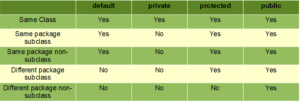As the name suggests access modifiers in Java helps to restrict the scope of a class, constructor, variable, method, or data member. There are four types of access modifiers available in java:
- Default – No keyword required
- Private
- Protected
- Public

- Default: When no access modifier is specified for a class, method, or data member – It is said to be having the default access modifier by default.
- The data members, class or methods which are not declared using any access modifiers i.e. having default access modifier are accessible only within the same package.
In this example, we will create two packages and the classes in the packages will be having the default access modifiers and we will try to access a class from one package from a class of the second package.
Java
// Java program to illustrate default modifier
package p1;
// Class Prutor is having Default access modifier
class Prutor
{
void display()
{
System.out.println("Hello World!");
}
}
Java
// Java program to illustrate error while
// using class from different package with
// default modifier
package p2;
import p1.*;
// This class is having default access modifier
class PrutorNew
{
public static void main(String args[])
{
// Accessing class Prutor from package p1
Prutor obj = new Prutor();
obj.display();
}
}
Output:
Compile time error
Private: The private access modifier is specified using the keyword private.
- The methods or data members declared as private are accessible only within the class in which they are declared.
- Any other class of the same package will not be able to access these members.
- Top-level classes or interfaces can not be declared as private because
1. private means “only visible within the enclosing class”.
2. protected means “only visible within the enclosing class and any subclasses”
Hence these modifiers in terms of application to classes, apply only to nested classes and not on top-level classes
In this example, we will create two classes A and B within the same package p1. We will declare a method in class A as private and try to access this method from class B and see the result.
Java
// Java program to illustrate error while
// using class from different package with
// private modifier
package p1;
class A
{
private void display()
{
System.out.println("PrutordotAi");
}
}
class B
{
public static void main(String args[])
{
A obj = new A();
// Trying to access private method
// of another class
obj.display();
}
}
Output:
error: display() has private access in A
obj.display();
protected: The protected access modifier is specified using the keyword protected.
The methods or data members declared as protected are accessible within the same package or subclasses in different packages.
In this example, we will create two packages p1 and p2. Class A in p1 is made public, to access it in p2. The method display in class A is protected and class B is inherited from class A and this protected method is then accessed by creating an object of class B.
Java
// Java program to illustrate
// protected modifier
package p1;
// Class A
public class A
{
protected void display()
{
System.out.println("PrutordotAi");
}
}
Java
// Java program to illustrate
// protected modifier
package p2;
import p1.*; // importing all classes in package p1
// Class B is subclass of A
class B extends A
{
public static void main(String args[])
{
B obj = new B();
obj.display();
}
}
Output:
PrutordotAi
- public: The public access modifier is specified using the keyword public.
- The public access modifier has the widest scope among all other access modifiers.
- Classes, methods, or data members that are declared as public are accessible from everywhere in the program. There is no restriction on the scope of public data members.
Java
// Java program to illustrate
// public modifier
package p1;
public class A
{
public void display()
{
System.out.println("PrutordotAi");
}
}
package p2;
import p1.*;
class B
{
public static void main(String args[])
{
A obj = new A;
obj.display();
}
}
Output:
PrutordotAi
Important Points:
- If other programmers use your class, try to use the most restrictive access level that makes sense for a particular member. Use private unless you have a good reason not to.
- Avoid public fields except for constants.
